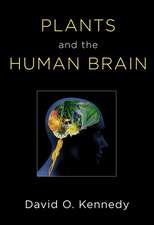Flora Unveiled: The Discovery and Denial of Sex in Plants
Autor Lincoln Taiz, Lee Taizen Limba Engleză Hardback – 9 feb 2017
Preț: 541.49 lei
Preț vechi: 718.76 lei
-25% Nou
Puncte Express: 812
Preț estimativ în valută:
103.65€ • 112.62$ • 87.12£
103.65€ • 112.62$ • 87.12£
Carte tipărită la comandă
Livrare economică 10-16 aprilie
Preluare comenzi: 021 569.72.76
Specificații
ISBN-13: 9780190490263
ISBN-10: 0190490268
Pagini: 544
Ilustrații: 215
Dimensiuni: 239 x 168 x 38 mm
Greutate: 0.93 kg
Editura: Oxford University Press
Colecția OUP USA
Locul publicării:New York, United States
ISBN-10: 0190490268
Pagini: 544
Ilustrații: 215
Dimensiuni: 239 x 168 x 38 mm
Greutate: 0.93 kg
Editura: Oxford University Press
Colecția OUP USA
Locul publicării:New York, United States
Recenzii
Flora Unveiled: The Discovery and Denial of Sex in Plants is a tour de force written by the eminent plant physiologist Lincoln Taiz and his wife Lee, a biologist. It is destined to be a classic.
When botanist Linnaeus wrote in 18th-century Europe about "brides" and "bridegrooms" and sexual practices in the marriage beds of the Vegetable Kingdom, he joined cultural conversations about women, men, and plants that had been going on for centuries. This fascinating and very welcome book by two plant biologists offers historical perspectives on ideas about plant reproduction, especially disputes between "sexualists" and "asexualists." Based in energetic research and richly illustrated, it melds the history of science with current gender studies about cultural factors that shape scientific ideas. Lincoln Taiz and Lee Taiz track associations dating back to Mesopotamian vegetation goddesses and forward into Romantic writings between women, flowers, fertility, sexuality, and qualities gendered "feminine," especially what the authors term "the plants-as-female gender bias."
This book presents an impressive, highly readable, and beautifully illustrated panorama of the way that our understanding of sex, and ultimately sex in plants, expanded from the Stone Age to the 19th century. In the scholarly hands of Lincoln and Lee Taiz, the puzzle of plant reproduction gives us a fascinating mirror into human thought as it has grown in complexity through the ages. A masterpiece of exposition that will sturdily stand with the passage of time.
What are flowers for? With gusto and deep learning, Flora Unveiled explains why humanity took millennia to figure out that plants have sex -- and why that great discovery met with disbelief and disgust. A classic of scientific and cultural exposition, with surprises on every page!
This is a magnificent book, both erudite and engaging. Never losing their guiding thread of vegetal sexuality, Lincoln and Lee Taiz successfully cross-pollinate the specimens of knowledge that grow on the fields of plant science, philosophy, religious studies, and aesthetics. Flora Unveiled is better than a revelation; it is the event of truth (Heidegger's un-concealment) blossoming in the ever-metamorphosing shape of a plant.
Flora Unveiled is not only a scholarly work of great erudition, it is a true labour of love, and deserves to be read by all (not just the plant-minded). The authors are to be congratulated in giving us such an accomplished botanical detective story.
When botanist Linnaeus wrote in 18th-century Europe about "brides" and "bridegrooms" and sexual practices in the marriage beds of the Vegetable Kingdom, he joined cultural conversations about women, men, and plants that had been going on for centuries. This fascinating and very welcome book by two plant biologists offers historical perspectives on ideas about plant reproduction, especially disputes between "sexualists" and "asexualists." Based in energetic research and richly illustrated, it melds the history of science with current gender studies about cultural factors that shape scientific ideas. Lincoln Taiz and Lee Taiz track associations dating back to Mesopotamian vegetation goddesses and forward into Romantic writings between women, flowers, fertility, sexuality, and qualities gendered "feminine," especially what the authors term "the plants-as-female gender bias."
This book presents an impressive, highly readable, and beautifully illustrated panorama of the way that our understanding of sex, and ultimately sex in plants, expanded from the Stone Age to the 19th century. In the scholarly hands of Lincoln and Lee Taiz, the puzzle of plant reproduction gives us a fascinating mirror into human thought as it has grown in complexity through the ages. A masterpiece of exposition that will sturdily stand with the passage of time.
What are flowers for? With gusto and deep learning, Flora Unveiled explains why humanity took millennia to figure out that plants have sex -- and why that great discovery met with disbelief and disgust. A classic of scientific and cultural exposition, with surprises on every page!
This is a magnificent book, both erudite and engaging. Never losing their guiding thread of vegetal sexuality, Lincoln and Lee Taiz successfully cross-pollinate the specimens of knowledge that grow on the fields of plant science, philosophy, religious studies, and aesthetics. Flora Unveiled is better than a revelation; it is the event of truth (Heidegger's un-concealment) blossoming in the ever-metamorphosing shape of a plant.
Flora Unveiled is not only a scholarly work of great erudition, it is a true labour of love, and deserves to be read by all (not just the plant-minded). The authors are to be congratulated in giving us such an accomplished botanical detective story.
Notă biografică
Lincoln Taiz is Professor Emeritus at the Department of Molecular, Cell, and Developmental Biology, University of California, Santa Cruz, and a Fellow of the American Society of Plant Biologists. He has published over a hundred and fifty research papers on a broad range of topics in plant physiology, and is the co-author of the standard textbook in the field, Plant Physiology and Development, currently in its sixth edition.Lee Taiz, a research biologist specializing in electron microscopy, co-authored numerous papers on plant biology and on the history of science while on the staff of the Cell and Molecular Biology Department at the University of California, Santa Cruz. Her paintings, primarily on botanical subjects, have been exhibited widely, and appear in books, periodicals, and exhibition catalogs.

















